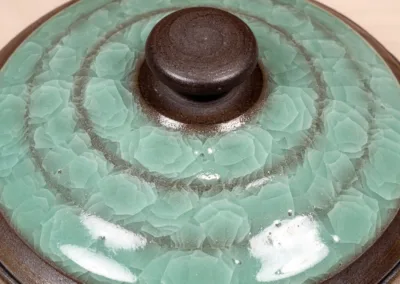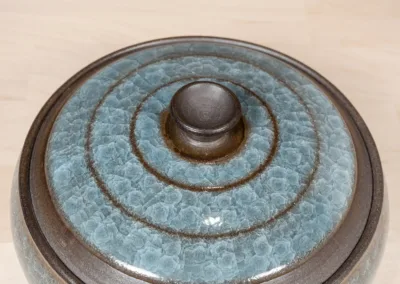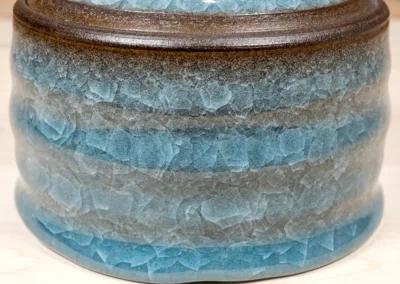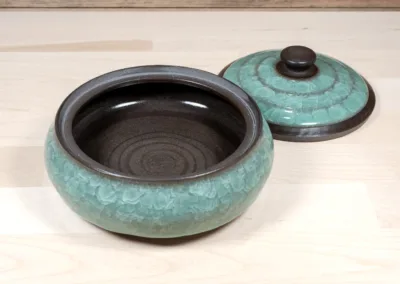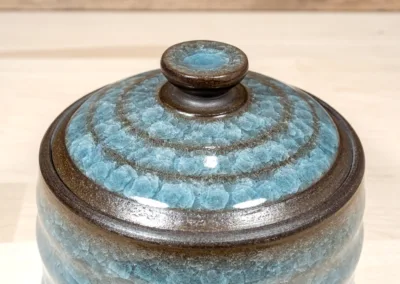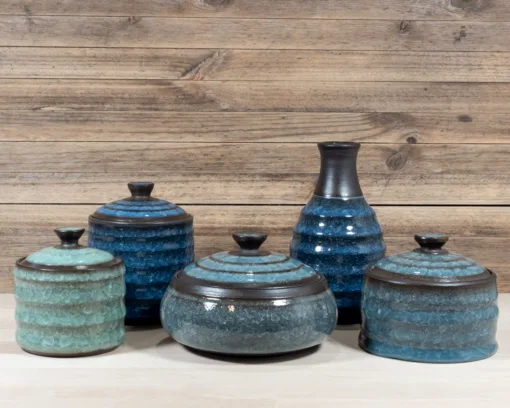Ice crackle
A glaze with many names: ice crackle, tortoise shell, snowflake and many more. Just like the appearance leaves room for a surprise
Testing and discovery
I first discovered the glaze from some pictures I saw in internet. It was stunning, when I saw it, I know that this is going to be my glaze of choice, something that one day has to be the bases of my signature collection. I looked for more information about it and studied the glaze and the origin of it. In almost every kiln firing I had test samples of different vessels and test tiles to discover how this glaze can be put to work, how to fire it, what clay it works with. I have lost count of the tests I have made with it until finally I came with a solution that worked out, not only technically but also aesthetically revealing the beauty on its most.
I commonly glaze my work from the outside with the ice crackle glaze and inside with a regular glossy transparent glaze. This leaves the vessel fully functional and safe to use for whatever purpose. I also do the ceramics ware like bowls or decorative plates with this glaze covered wholly with this glaze.
The origin of Ice Crackle glaze
The origin of the glaze goes down to Song dynasty of China where one of the five famous kilns were making high status stoneware, whose surface decoration relied heavily on crackled glaze, randomly grazed by a network of crack lines in the glaze. Commonly called Guan Crackle, the Guan, Ru and Ge ware were all nice examples of crazing as a decoration. Later, Japanese have learned and mastered the technique from Chinese masters and enhanced and perfected in their way.
About the Ice-Crackle glaze
With other names this glaze is called Snowflake Crackle, Fish Scale Crackle, Ice Crackle, Ice-like Crazing, and Tortoise Shell Crackle.
In ceramics the cracks are commonly called crazed and is considered a glaze defect when the clay body and glaze don’t fit well. But when we make them purposely as an element of decoration, we call this crackle glaze.
Regardless how it is called it’s a crazed graze. As the glazed is applied in a very thick layer the fractures run not only vertically throw the glaze but also horizontally inside the glaze, this is what develops these beautiful patterns. Almost always the pattern is distinct hexagonal shape, smaller or lager shapes that very much depend on the glaze chemistry, firing, the shape of the ware and many other things. The force between the glaze and the stoneware is so intense it’s not rare that the ware does not withstand the firing when applied too thick and the clay body is too thin. That force and friction is what also creates that distinctive beauty.
Different styles
Ice crackle
A glaze with many names: ice crackle, tortoise shell, snowflake and many more.
Made with thick layer of crackle glaze where the fractures develop the look of cracked ice. Hence also its name – Ice Crackle.
Stardust
When the odds become even during the firing process the iron rich glaze develops beautiful golden microcrystals. Sometimes covering the whole ware with golden hue and other times just few golden sparks like stars.
Glaze that’s originally called “Tea-Dust” and was mainly used in Imperial ware.
Everyday
You come home, make tea, sit in the armchair, and catch your breath...
Here are cups, bowls and other simple dishes that give everyday life a calm, clean, modest, and rustic feel.
Made from different colored stoneware where mainly inside of the ware is glazed so that the clay itself would be brought out.







